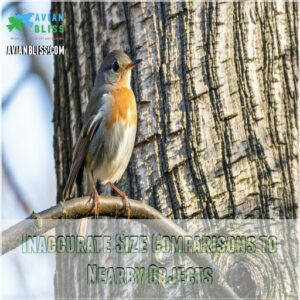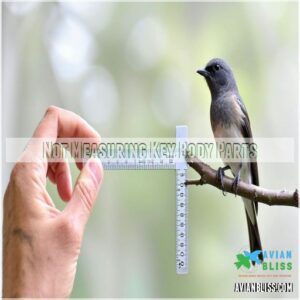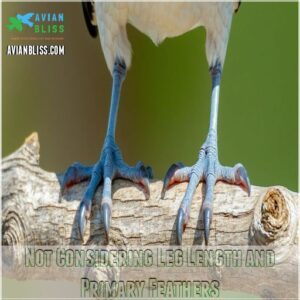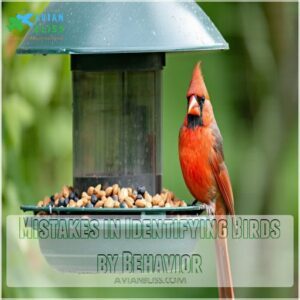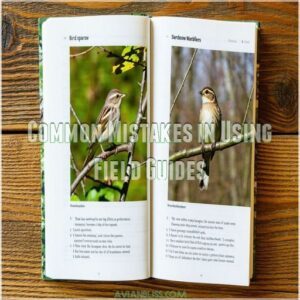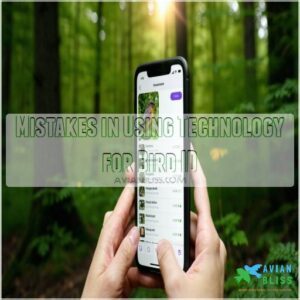This site is supported by our readers. We may earn a commission, at no cost to you, if you purchase through links.
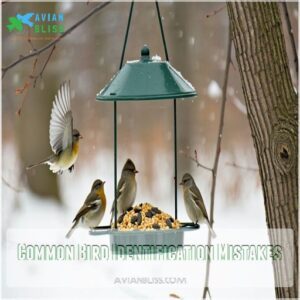
You might rely too heavily on color without considering bird size, shape, or behavior clues.
Remember, a sparrow’s song is as distinctive as its feathers!
Ignoring vocalizations or habitat can lead to misidentifications; birds don’t just tweet, they have dialects.
Focusing solely on plumage overlooks seasonal changes—winter coats aren’t just for people.
And don’t forget your binoculars—they’re your best allies, unlike those stubborn bare eyes.
Is technology confusing you?
It’s useful but don’t let it dictate every call.
Ready to fly through more bird insights?
Table Of Contents
- Key Takeaways
- Common Bird Identification Mistakes
- Mistakes in Judging Bird Size
- Errors in Identifying Bird Shapes
- Misidentifying Birds by Plumage
- Mistakes in Identifying Birds by Behavior
- Common Mistakes in Using Field Guides
- Mistakes in Using Technology for Bird ID
- Avoiding Common Bird Identification Mistakes
- Frequently Asked Questions (FAQs)
- How difficult is it to identify a bird?
- How do I find out if a bird is a real bird?
- What makes a good bird ID?
- What is the most common mistake in bird control?
- How do you know what’s wrong with a bird?
- What is the hardest bird to identify?
- What are the tips for bird ID?
- How can I tell apart similar-looking birds?
- What are the best apps for bird identification?
- Whats the easiest way to learn bird songs?
- Why are some birds harder to identify than others?
- How do I improve my bird identification skills?
- Conclusion
Key Takeaways
- Don’t rely solely on color; consider size, shape, and behavior for accurate identification.
- Pay close attention to habitat, vocalizations, and flight patterns; these provide crucial clues.
- Account for plumage variations due to age, sex, and season; juvenile and female plumage often differs significantly.
- Use field guides and technology as tools, but prioritize careful observation and a systematic approach.
Common Bird Identification Mistakes
When you’re out birdwatching, it’s easy to make errors by overlooking key features like bill shape or mistaking a smaller bird for its larger cousin.
Recognizing these common pitfalls helps your bird identification be more precise and enjoyable.
Overlooking Key Physical Characteristics
Ever wonder why some bird identification errors happen?
It’s all about the little details, like ignoring bird markings or beak shape.
Look closely at wing patterns and leg color—they’re key for identifying that mystery bird.
Don’t miss out on feather texture, either.
Mastering these bird identification challenges requires a sharp eye and a little patience.
Misjudging Bird Size and Shape
You’ve nailed those subtle feather patterns, but have you really gotten the bird’s size right? Size estimation is tricky! It’s easy to misjudge a bird’s size and shape. Here’s why:
- Silhouettes can be deceiving; posture matters!
- Size comparisons to nearby objects are often inaccurate.
- Don’t forget to measure key body parts—wingspan, tail length—for better size judgment.
Accurate size assessment improves your bird identification skills.
Ignoring Habitat and Behavior Clues
While size and shape are important, overlooking habitat and behavior can lead you astray in bird identification.
Birds aren’t just defined by plumage; they’re known by their foraging habits and nesting sites.
Consider seasonal movements and flock behavior.
Observe their unique flight patterns and listen to their calls.
These invaluable clues often reveal more than a quick glance ever could.
Failing to Consider Plumage Variations
Bird identification can get tricky with plumage variations.
Imagine mistaking a young bird’s plumage for a different species – oops!
Seasonal molting, age-based changes, and sex-specific colors can lead to bird identification errors.
To help you navigate these variations, consider using a resource like a plumage variation guide to understand the diverse outfits birds wear.
Keep a keen eye on juvenile plumage and remember, similar bird species often sport different outfits.
Don’t let these subtle changes trip you up.
Mistakes in Judging Bird Size
When you’re out birdwatching, it’s easy to misjudge a bird’s size by comparing it to nearby objects like trees or benches.
To avoid this pitfall, focus on using silhouettes and measuring key body parts to improve accuracy in your identifications.
Silhouette and Posture Misinterpretations
Misreading bird silhouettes leads to identification mistakes.
Your mind plays tricks with size illusions as similar species fly against the sky.
Postures create silhouette variations, making you ponder, "Is it a hawk or an eagle?"
Consider these tips:
- Analyze wingspan clues for flight shape insights.
- Observe posture impact to differentiate species.
- Avoid silhouette misjudgments by watching behavior.
Inaccurate Size Comparisons to Nearby Objects
When figuring out bird size, it’s easy to trip over size illusions.
You might compare a bird to a nearby branch or rock, but these visual cues often deceive.
Your trusty tree stump may not be the best size comparison.
Watch for these bird identification mistakes to avoid mismatches in size estimation.
Embrace your inner Sherlock for precise observation.
Not Measuring Key Body Parts
Tackling bird identification can feel like measuring spaghetti.
You’ve got to measure key features like wingspan, bill length, and tail length for accurate bird size estimation.
Overlooking these details leads to bird identification mistakes, such as misjudging a bird’s size by not comparing its shape to silhouettes and body parts like bill shape reflects diet preferences.
Missed bird measurement can skew your understanding.
By comparing leg length or head size, you sharpen your bird size comparisons and mastery in avian identification.
Errors in Identifying Bird Shapes
You’d be surprised how often we misjudge a bird’s shape, overlooking key details like bill size, tail structure, or even the length of its legs.
Mastering bird shape identification requires careful attention to these features, comparing your observations to detailed field guides to avoid common pitfalls.
Misidentifying Bill Shape and Size
Just when you think you’ve got bird size down, don’t let bill shape variations throw you off.
Bird beak size isn’t just for show; it reflects their diet and lifestyle.
Bill length impact can be misleading, leading to bird identification mistakes.
Misidentifying these features can send you the wrong way, so pay attention and sharpen those birding skills!
Confusing Tail Shapes and Wing Shapes
Rarely do tail shape variations and wing shape clues reveal themselves without a bit of sleuthing.
Misjudging bird silhouettes during flight can lead to common confusions in bird identification.
Compare the graceful forked tail of a swallow to the straight-edge of a hawk.
Spotting these subtleties enhances your skills, refining how you interpret each bird’s shape and size without a hitch.
Overlooking Head Shape, Neck Length, and Body Shape
Attention to head shape, neck length, and body shape should be your radar for spotting bird identification mistakes. These features can be as telling as a mystery novel’s plot twist:
- A heron’s long neck is unmistakable.
- Bulky body shape might hint at an eagle.
- Short neck suggests a dove or pigeon.
- Unique head shape can reveal species secrets.
Not Considering Leg Length and Primary Feathers
Leg length can be a real head-scratcher in bird identification.
Birds that wade often have longer legs to navigate wetlands, while perching birds sport shorter ones.
For more guidance on overcoming such challenges, check out products related to common birding mistakes.
Primary feathers also need attention.
They influence a bird’s agility and flight patterns.
Remember, those feathers contribute to wing length and agility.
Don’t skip these details when avoiding common bird identification mistakes.
Misidentifying Birds by Plumage
When you’re identifying birds by plumage, it’s easy to be thrown off by age, sex, and seasonal changes that affect their feathers.
Don’t forget to double-check your field guide carefully and make sure the bird is actually in its geographical range to avoid a misidentification mishap.
Not Accounting for Age, Sex, and Seasonal Variations
Bird identification can trip you up, especially when plumage changes with age, sex, or seasons.
Juveniles often look entirely different, like teenagers experimenting with styles.
During molting, feathers shift, altering appearances across breeding seasons.
Male and female birds flaunt distinct looks due to sexual dimorphism.
These nuances can lead to common bird misidentification, so watch for seasonal variations and subtle gender differences.
Ignoring Female and Immature Bird Plumage
Remember those age, sex, and seasonal plumage shifts? Don’t forget, female and immature birds often sport completely different colors than their adult male counterparts.
This can really throw you off!
- Think vibrant reds on a male cardinal versus the duller brown of a female.
- Or a juvenile eagle’s brown plumage compared to its parent’s iconic white head.
- Even seasonal molting can dramatically change a bird’s appearance.
- So, always check for those sex-specific colors and age-related differences in your field guide. It’s a common bird identification mistake to overlook these plumage variations.
Failure to Consult Field Guides With Range Maps
Don’t overlook the importance of range maps in field guides when tackling bird identification.
Misjudging geographical boundaries can lead to errors, especially with bird migration patterns altering species distribution.
Familiarizing yourself with regional bird populations like those found in Eastern North America’s vibrant Northern Cardinals and clever Blue Jays through bird identification by location basics and regional birding.
Even seasoned birders can fumble rare bird sightings by skipping this step.
Confirming range map accuracy makes sure you’re spotting birds likely to be, improving your regional birding success.
Not Verifying Geographical Range
Just like using a map to find your way home, double-checking a bird’s geographical range is key.
Ignoring range maps might lead you to mistake a rare bird sighting for something else.
Birds often migrate, shifting their usual haunts.
Explore regional birding insights, and remember, even common feathered friends can surprise you outside their typical zones.
Mistakes in Identifying Birds by Behavior
When identifying birds, it’s easy to overlook the importance of behavior, like flight patterns and vocalizations, which can lead to misidentifications.
Don’t let the quirky antics of birds fool you; a careful observation of their actions, such as social behavior and foraging habits, can provide key identification clues.
Not Observing Flight Patterns and Movements
Birds on the move reveal secrets you shouldn’t ignore.
Flight patterns can be like fingerprints for species: soaring hawks, darting swifts, and hovering hummingbirds tell tales of identity.
Tune into these nuances for better identification.
- Feel the thrill of correctly spotting a gliding bird.
- Marvel at the elegance of soaring birds.
- Discover hidden wing shapes.
- Enhance your bird-watching skills.
- Master bird behavior observations.
Ignoring Vocalizations and Calls
While it’s easy to focus on how birds move, tuning into their songs opens up a whole new level of identification.
Bird vocalizations offer clues; each species sings its own tune.
Ear training helps you catch these calls, avoid common bird identification mistakes, and connect with nature like never before.
Sound recordings can also enhance your birding journey.
Not Considering Habitat and Foraging Habits
Too often, you skip the clues nature’s buffet offers. Look out for:
- Bird feeding habits: A warbler might prefer insects, while a finch goes for seeds.
- Habitat preferences: Marshes for a heron, forests for an owl, which is also influenced by seasonal migration patterns.
- Food sources: Check for nearby berries or bugs.
- Niche specialization: Woodpeckers in trees, plovers on shores.
Understanding these helps spot bird species by behavior.
Failure to Analyze Social Behavior
Social behavior offers valuable clues.
Don’t overlook these important aspects of bird identification!
| Behavior | Species Example | Identification Clue |
|---|---|---|
| Flocking patterns | Starlings, sparrows | Tight formations vs. loose aggregations |
| Bird interactions | Bluebirds, cardinals | Aggressive interactions or cooperative foraging |
| Social hierarchies | Chickens, pigeons | Dominance displays, pecking order |
Ignoring these nuances can lead to misidentification.
Careful observation reveals the secrets of bird behavior!
Common Mistakes in Using Field Guides
You’ll often find that not using field guides specific to your region or relying solely on images can lead to misidentification.
Misidentification can occur when you mistake a sparrow for a warbler just because of a misleading picture.
Remember to consult multiple guides to make sure you’re not mistaking a sparrow for a warbler just because of a misleading picture.
Not Using Field Guides Specific to The Region
You might miss identifying that bird if you don’t use field guides specific to your region.
Birds play hide and seek with boundaries and often look different depending on where you are.
Recognizing distinctive field marks like eyebrow stripes, wingbars, or throat patches can greatly aid in identification.
Avoid being bamboozled by:
- Regional bird variations – They’re real and tricky.
- Bird range maps – Essential for accurate IDs.
- Local bird guides – Your best feathered friends.
Not Consulting Multiple Field Guides
Field guide limitations often trip up even experienced birdwatchers.
Not consulting multiple guides can leave you misidentifying birds and missing key details.
Each guide has its own take on regional variations and species range.
Cross-referencing boosts your identification accuracy and reduces bird identification mistakes like confusing lookalikes.
Expert advice: diversify your sources to minimize field guide accuracy pitfalls!
Relying Solely on Images
Though field guide images can paint a vivid picture, relying solely on them can trip you up.
Birds are master shape-shifters; plumage changes with seasons and ages, while size and posture vary.
Utilize descriptions to catch bird lookalikes or confusing species.
Develop a keen eye for details beyond the image, embracing subtle clues that guide true bird identification mastery.
Mistakes in Using Technology for Bird ID
When using technology for bird identification, don’t make the mistake of relying too heavily on apps, as they can’t replace your observational skills.
While mobile apps and citizen science platforms offer great tools for bird ID, they should complement your natural learning, not substitute it.
Not Using Mobile Apps for Visual IDs
Often overlooked, bird identification apps can be a game-changer.
While field guides are trusty companions, apps with image recognition provide quick visual IDs right from your pocket.
They help avoid common bird identification mistakes and give you freedom to roam while matching details with accuracy.
Don’t miss out on the tech-savvy way to master identifying birds correctly.
Not Participating in Citizen Science Platforms
Mobile apps offer quick visual IDs, but don’t stop there!
Citizen science platforms, like eBird, are powerful tools.
Contributing your sightings helps scientists collect valuable data on bird populations.
Think of it as adding your piece to a giant bird identification puzzle.
You’ll learn more, and your data helps everyone.
It’s a win-win for bird lovers and researchers alike!
Plus, you’ll avoid confusing similar species by comparing notes with other bird enthusiasts.
Relying Too Heavily on Technology
In birding, falling back on technology without practicing field skills is like relying only on GPS and ignoring paper maps.
Bird identification apps and image recognition offer quick answers, but they’re prone to data bias.
Remember, citizen science thrives on sharp eyes and keen ears.
Master the balance—let these tools support, not replace, your natural observation skills.
Avoiding Common Bird Identification Mistakes
To identify birds accurately, focus on recording your observations carefully and systematically studying their features.
Embrace the learning process by keeping an open mind and avoiding jumping to conclusions, even when the birds seem familiar at first glance.
Practicing Careful Observation and Record-Keeping
Observation is key in birdwatching.
Keep a birdwatching journal and make field sketches to capture those fleeting details.
Consider investing in a dedicated birdwatching journal kit Birdwatching Journal Online to help you stay organized.
Detailed notes can help you avoid bird identification mistakes.
Snap photos for reference but don’t rely solely on them.
Strengthen your bird identification expertise and accuracy by recording identification challenges, helping you avoid identifying birds incorrectly in future adventures.
Using a Systematic Approach to Identification
Keen observation is just the start; a systematic approach cements your skills.
Use field guides to pinpoint key features, like bird anatomy and size, steering clear of common identification errors.
Tackle this process like assembling a puzzle—methodical step-by-step.
Recognize patterns with patience, ensuring each piece fits just right.
Master these techniques, and you’ll become an expert birder in no time.
Embracing The Learning Process and Avoiding Assumptions
Tackle bird ID challenges by thinking like Sherlock Holmes—observant and curious.
Embrace the learning curve and let go of assumptions:
- Keep an open mind, ready to spot unexpected details.
- Field guide use enhances your detective skills.
- Avoid biases by questioning first impressions.
- See mistakes as clues for better insights next time.
Frequently Asked Questions (FAQs)
How difficult is it to identify a bird?
Identifying a bird can be tricky due to its fleeting movements and diverse appearances.
It requires patience, observation, and often a mix of visual and auditory cues.
With practice, though, it becomes an engaging and rewarding skill.
How do I find out if a bird is a real bird?
Spotting a real bird involves observing its movement, listening to calls, and noting habitat.
Real birds fly and interact with their environment, unlike decoys.
Use apps or guides for reliable identification and confirmation.
What makes a good bird ID?
Think of bird ID as solving nature’s puzzle; a good one relies on keen observation, focusing on size, shape, colors, behaviors, and calls.
Combine these clues with field guide insights for a complete picture.
What is the most common mistake in bird control?
Overlooking habitat specifics often leads to bird control mistakes.
You might ignore a bird’s environmental preferences or seasonal patterns, wasting resources on ineffective methods.
Tailor strategies to fit unique ecological roles for better results.
How do you know what’s wrong with a bird?
Ever noticed how a bird doesn’t tweet like it used to?
That irony might hint at illness.
Look for signs like drooping wings, disheveled feathers, or lethargy.
These clues help you determine if something’s amiss.
What is the hardest bird to identify?
Sometimes, identifying flycatchers can be tricky.
They share similar colors and sizes, leaving you puzzled over which species you’ve spotted.
Learning their distinct calls helps, but mastering their identification requires patience and a keen eye.
What are the tips for bird ID?
Bird identification? It’s a thrilling detective story! Sharpen your skills: scrutinize size, shape, color, and behavior. Use a field guide, and don’t forget your binoculars! Happy birding!
How can I tell apart similar-looking birds?
Use bill shape, plumage patterns, and size proportions to distinguish similar-looking birds.
Observing behavior, flight patterns, and habitat can also help.
Field guides and apps offer additional clues to pinpoint differences more effectively.
What are the best apps for bird identification?
Merlin Bird ID, iNaturalist, and eBird are top apps for bird identification.
They offer features like image recognition, community sightings, and detailed guides.
You’re tapping into a handy toolkit for identifying your feathered friends easily.
Whats the easiest way to learn bird songs?
Start by focusing on one bird’s song daily, using apps like BirdNET or song playlists.
Mimic the sounds, associate them with distinct traits, and gradually expand your repertoire.
Listening outdoors strengthens recognition through context and repetition.
Why are some birds harder to identify than others?
Birds can be tough to ID due to similar plumage across species, seasonal changes in appearance, or overlapping habitats.
Subtle differences in size, shape, and behavior add layers to the challenge, making identification a real puzzle.
How do I improve my bird identification skills?
Like putting together a jigsaw puzzle, practice observation, note color patterns, bill shapes, and melodies.
Use apps and guides for reference.
Familiarity with local species and regular field trips refine your identification skills.
Conclusion
Surprisingly, about 30% of birdwatchers make common bird identification mistakes, often relying too heavily on color alone.
To sharpen your skills, remember to take into account bird size, shape, and behavior.
Pay attention to vocalizations and the habitat; these details offer key clues.
Use field guides and technology wisely, but don’t let them replace careful observation.
By embracing a systematic approach and learning from each experience, you’ll greatly improve your identification accuracy and enjoy birdwatching even more.


